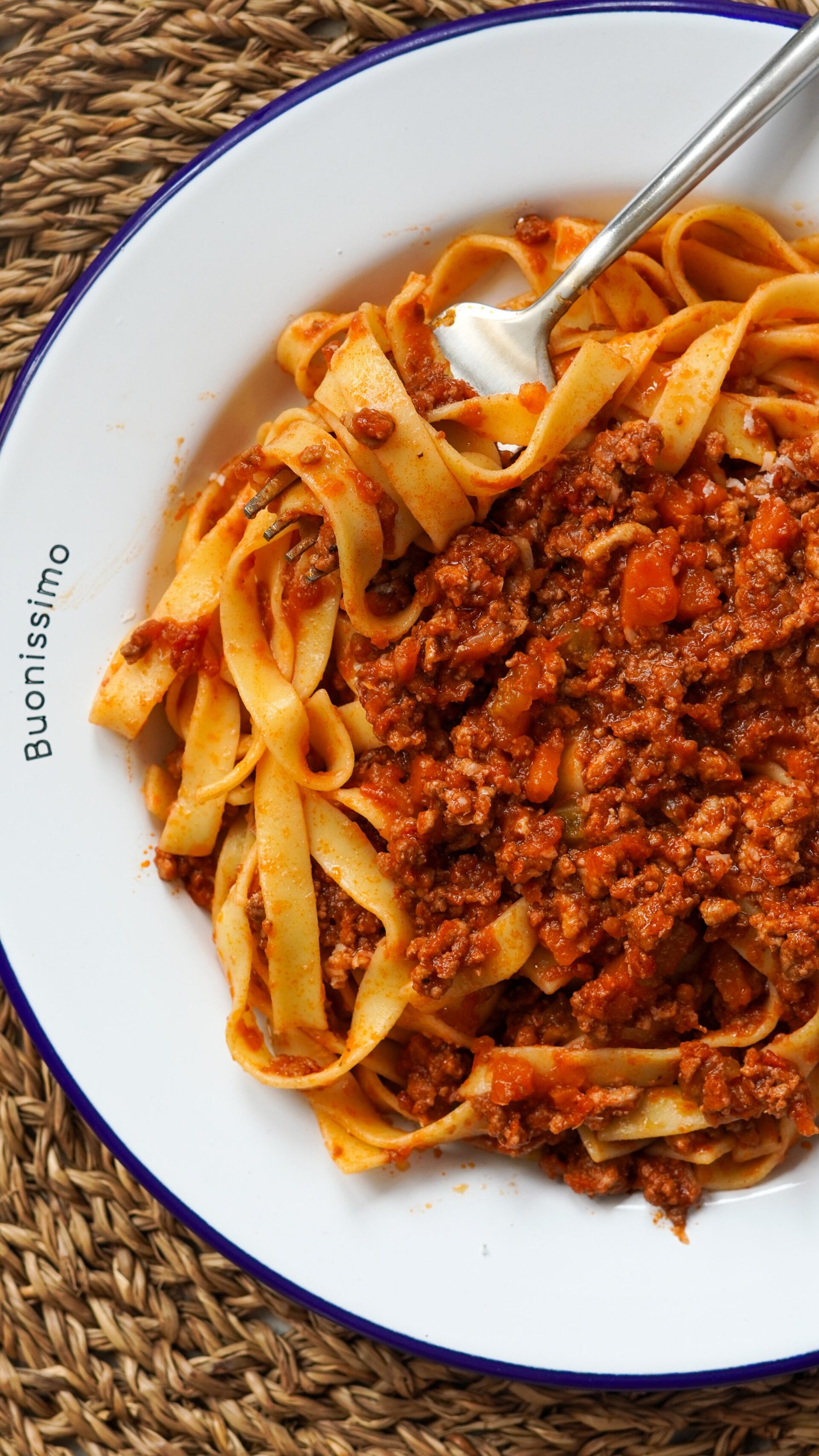This recipe is all about taking your time to create something truly special. Ragù isn’t just a dish; it’s an Italian tradition that brings people together around the table. Slow cooking transforms simple ingredients into a sauce that’s rich, hearty, and packed with authentic flavour.
Perfect for batch cooking or a cosy Sunday lunch, this classic ragù comes straight from Emilia-Romagna—the Italian region I’m proud to call home. It’s a recipe I grew up with, one that feels like a warm hug from my heritage.
Each step of the process is worth it: from sautéing the vegetables to slow-simmering the sauce. The result? A velvety, flavourful ragù that pairs perfectly with tagliatelle (trust me, it’s not meant for spaghetti!).
With every bite, you’ll taste the care, tradition, and love that goes into making a proper ragù. It’s a dish that connects you to the heart of Italian cooking, one delicious spoonful at a time.

What is ‘Bolognese ragù’?
Bolognese ragù (or Ragù alla Bolognese) is a slow-cooked Italian meat sauce that originates from Bologna, in the Emilia-Romagna region of northern Italy. It’s rich, savoury, and deeply comforting—a true cornerstone of Italian cuisine. Bolognese is a meat-based sauce made with finely chopped onion, carrot, and celery (the Italian soffritto), gently sautéed in olive oil and paired with tagliatelle, not spaghetti.
Fun fact: In 1982, the Accademia Italiana della Cucina officially registered the traditional recipe with Bologna’s Chamber of Commerce to preserve its authenticity. Yes, Italians really did write an official document to protect the original Bolognese recipe—that’s how serious we are about food! But like many Italian classics, there are as many versions as there are families. The recipe I’m sharing today doesn’t follow the official one to the letter—it’s the version I grew up with, the one made in real home kitchens by parents, nonne, and friends. It’s the one that tastes like childhood, comfort, Sunday lunches and local village fair with my family and friends.
Tips
- Traditional Bolognese uses a mix of beef and pork. Choose high-quality ground beef (ideally 80% lean) and ground pork for the best flavour. .
- The base of any good Bolognese is the soffritto (a mix of finely chopped onion, carrot, and celery). Don’t rush this step—cook it slowly in olive oil or butter until it’s soft and fragrant.
- Bolognese is not a tomato-heavy sauce. Use a small amount of tomato sauce to give it just a touch of richness. The focus should be on the meat and the slow-cooked flavours, with tomatoes as a subtle background note.
- Bolognese is all about patience. After adding wine, stock, and any tomato paste, let the sauce simmer on low heat for at least 2 to 3 hours. Stir it occasionally and adjust the liquid (stock or wine) to ensure the sauce doesn’t dry out. This long cooking time allows the flavours to meld beautifully.
- Use a dry white wine (or red, depending on your preference) to deglaze the pan after browning the meat. This adds depth and a lovely richness to the sauce.
- Season gradually with salt, pepper, and a pinch of nutmeg (a traditional addition). Always taste and adjust as you go—simmering can reduce the flavour, so a final seasoning check is essential.
- If you have time, let your Bolognese sauce rest for a few hours (or even overnight). This allows the flavours to develop and marry fully. Reheat it gently before serving.
- Traditional Bolognese is served with tagliatelle not spaghetti!
- Bolognese is always finished with a generous sprinkle of freshly grated Parmigiano-Reggiano or Grana Padano for an extra layer of richness and flavour and a drizzle of good quality extra-virgin olive oil.
Swaps
Meat: if you are looking for a vegetarian version of this dish try Sugo Finto (Tuscan Vegetable “Fake” Sauce)
Tagliatelle: the traditional ragù is traditionally paired with tagliatelle but you can add to any pasta of your choice.
Add-Ons
Herbs: While the specific herbs can vary, bay leaves, thyme, oregano, and sometimes rosemary are common additions. A sprig of fresh rosemary can add a lovely aromatic touch, though it’s usually removed before serving.
Sausage and bacon (or pancetta) are great additions to Bolognese, adding depth and richness to the sauce.
Storage
Fridge: let it cool completely before storing it in an airtight container. It can be kept in the fridge for 3–4 days.
Freezer: If you want to store it for a longer period, you can freeze it for up to 3 months. When reheating, add a little water or stock if the sauce has thickened too much during storage. It makes the best make ahead meal to feed a crowd!
More recipes with Minced Meat

Authentic Bolognese Ragù
Ingredients
- 300 g pork mince
- 200 g beef mince
- 2 can chopped tomatoes @mutti
- 1 small yellow onion, sliced finely
- 1 celery stick, chopped in small cubes
- 1 carrot, chopped in small cubes
- ½ glass red wine
- bay leaves
- nutmeg
- salt
Instructions
- In a large sauce pan add a drizzle of oil then add the vegetables. Cook until the vegetables are translucent.
- Add the mince. Brake it down and cook until the meat goes from pink to “white”.
- Add the wine and let evaporate, it should take only a few minutes.
- Add the tomato sauce and seasoning: grated nutmeg, salt, pepper and the bay leaves.
- Cook for 2 hours on a small flame and with the lid on: make sure you stir regularly, don’t leave the pan unattended for long periods of time. The wait will be worth it.
- If necessary add some hot water if it dries too much.
- Once ready, serve with tagliatelle (not spaghetti).
- Must topping: grated Parmesan cheese and a good quality extra virgin olive oil. These are not really optional if you want to experience the real Italian ragù.
